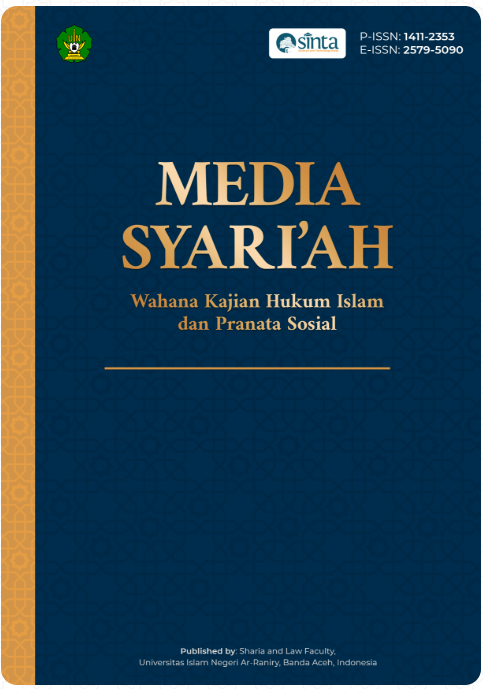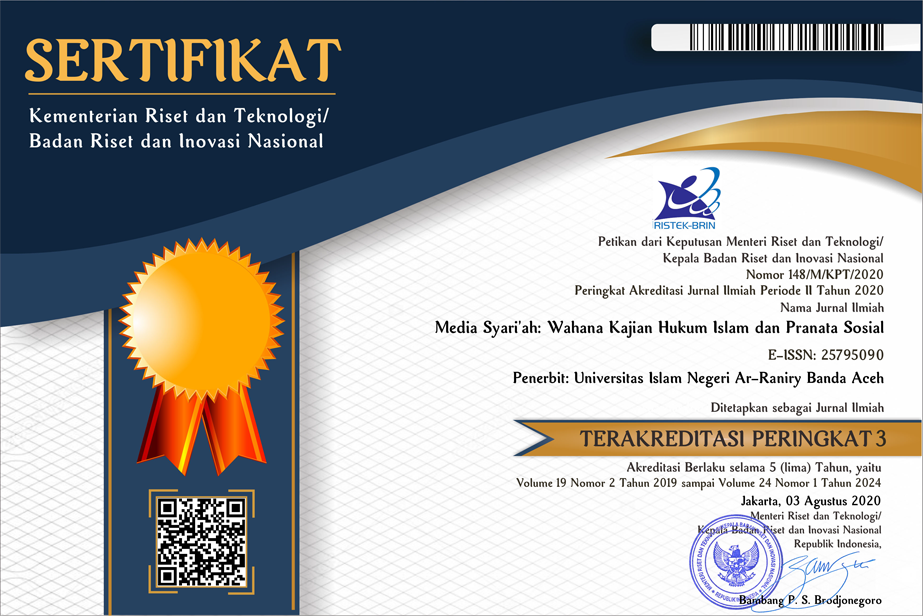Sujud Tilawa: Analysis of the Dalil in the Hadith and Fiqh
DOI:
https://doi.org/10.22373/jms.v26i1.24870Keywords:
sujud tilawa, hadith, fiqh, islamic shool of ulama.Abstract
Sujud Tilawah is a prostration that is performed when someone reads and hears the sajdah verse either in prayer or outside prayer. The ulema agree about sujud tilawah in Islam but have different opinions regarding the law on sujud tilawah. According to Hanafis, sujud tilawah is obligatory while the jumhur ulama say it’s recommended. This difference of opinion arises because the scholars differ in using hadith as proof in establishing the law. In this research, the author uses a qualitative research method with the type of library research and this research uses a comparative descriptive approach, which the author compares the hadiths used by Islamic school scholars as evidence in interpreting the law of sujud tilawah. The results of the research show that in the hadith book (Kutubussittah) there are thirteen hadiths showing the Prophet and aṣ-ṣaḥāba performing sujud tilawah after hearing the recitation of the sajdah verse and four hadiths showing the Prophet and aṣ-ṣaḥāba abandoning the act of sujud tilawah after hearing the sajdah verse. Furthermore, to enforce the law of sujud tilawah, the Hanafi School uses one hadith narrated by Ibn Majah number 1052. The Maliki School uses one hadith narrated by Bukhari number 1077. The Syafi'i school uses three hadiths narrated by Abu Dawud number 1404 and Bukhari number 1077 and number 2678. The Hanbali school uses two hadiths narrated by Abu Dawud number 1404 and by Bukhari number 1077. The Dzahiri school uses one hadith narrated by Abu Dawud number 1404.
References
Abaadi, A. T. M. S. al-H. A. (1990). A’unul Ma’bud. Darul Kutub Ilmiyah.
Al-Andalusi, A. M. A. B. A. B. S. B. H. (2003). Al-Muhalla bilasar. Darul Kutub Ilmiyah.
Al-Arifi, M. (2018). Fikih Ibadah Harian. Istanbul.
Al-Asqalani, I. H. (2003). Fathul Baari: Syarah Shahih Bukhari. Pustaka Azzam.
Al-Bukhari, A. A. M. B. I. bin I. A.-J. (2016). Shahih Bukhari. Al-Bushra.
Al-Bukhari, M. bin I. (2002). Shahih Al-Bukhari. Dar Ibnu Katsir.
Al-Kasani, I. A. A. B. B. M. (2003). Kitab Badai’ Al-Shanai’ Fi Tartib Al-Syarai’. Darul Kutub Ilmiyah.
Al-Nawawi, I. A. Z. Y. bin S. (2005). Al-Majmu’ syarah AI Muhadzab. Baitul Afkar Dauliyah.
Al-Qazwini, A.-H. A. A. M. B. Y. (1918). Sunan Ibn Majah.
Al-Tirmizi, A. ’Isa. (1998). Sahih Sunan al-Tirmizi. Daar Ibn Al-Jauzy.
An-Nasa’i, I. A. A. R. A. B. S. (2012). Kitab Sunan Ma’aruf Bi Sunan al-Kubra. Dar at-Ta’sil.
An-Nisaburi, I. A. H. B. A.-H. Q. (1991). Shahih Muslim. Darul Kutub Ilmiyah.
As-Sijistani, A. D. S. bin al-A. al-A. (1996). Sunan Abi Dawud. Darul Kutub Ilmiyah.
At-Tirmizi, I. A.-H. M. bin ‘Isa bin S. (2000). Shahih Sunan At-Tirmizi. Maktabah al-Ma’arif Lil Nasyar Wal Tauzi’.
M. Imam Pamungkas, & Maman Surahman. (2015). Fiqih 4 Madzhab. Al-Makmur.
Marfuah, M. (2019). Serba-Serbi Sujud Tilawa. Rumah Fiqih Publishing.
Muhammad bin Ismail Bukhari. (2008). Al-Sahih al-Bukhari. Dar Ibn Hazm.
Qudamah, M. A. M. A. bin A. bin M. bin. (1986). Al-Mughni. Darul Ulum Kutub.
Rifa’i, M. (2014). Fiqh Islam Lengkap. Karya Toha Putra.
Riza Anami, & Moh Jazuli. (2020). Ayat-Ayat Sajadah dalam Al-Qur’an Perspektif Fenomenologi. Jurnal Pemikiran Ilmu Keislaman, 3(1).
Rusyd, I. (2007). Bidayatul Mujtahid. Pustaka Azzam.
Ṭabari, A. J. M. ibn J. A.-. (1999). Jāmi’ al-Bayān fi Ta’wili al-Qur’ān. Dar al-Kitab al-Ilmiyah.
Downloads
Published
Issue
Section
License
MEDIA SYARI'AH: Wahana Kajian Hukum Islam dan Pranata Sosial has CC-BY-SA or an equivalent license as the optimal license for the publication, distribution, use, and reuse of scholarly work. Authors who publish with this journal agree to the following terms:
1. Authors retain copyright and grant the journal right of first publication with the work simultaneously licensed under a Creative Commons Attribution-ShareAlike 4.0 International License that allows others to share the work with an acknowledgment of the work's authorship and initial publication in this journal.
2. Authors are able to enter into separate, additional contractual arrangements for the non-exclusive distribution of the journal's published version of the work (e.g., post it to an institutional repository or publish it in a book), with an acknowledgment of its initial publication in this journal.
3. Authors are permitted and encouraged to post their work online (e.g., in institutional repositories or on their website) prior to and during the submission process, as it can lead to productive exchanges, as well as earlier and greater citation of published work (See The Effect of Open Access).
You are free to:
Share — copy and redistribute the material in any medium or format.
Adapt — remix, transform, and build upon the material for any purpose, even commercially.
The licensor cannot revoke these freedoms as long as you follow the license terms.
All papers published in MEDIA SYARI'AH: Wahana Kajian Hukum Islam dan Pranata Sosial are licensed under a Creative Commons Attribution-ShareAlike 4.0 International License.




.png)


.png)
.png)
.png)



